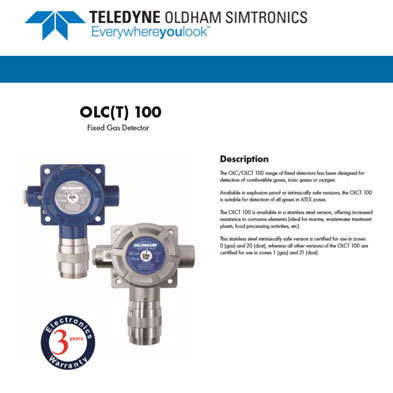We would like to inform you that we will be closed from 24 to 26 December 🎄 and during the afternoon of 31 December. ⭐ Season's Greetings!
Login
MyFFonseca
If you do not have an account MyFFonseca, please register and get access to exclusive content to registered users!
Create registryLogin
MyFFonseca
If you do not have an account MyFFonseca, please register and get access to exclusive content to registered users!
Create registry

Process, Instrumentation & Environment
OLCT 100/OLC 100 Toxic and Combustible Gas Detector - TELEDYNE Oldham
Designed for the detection of explosive gases, toxic gases or oxygen, this combustible gas detector comes with a Wheatstone bridge output (OLC 100) or 4-20mA output (OLCT 100). Whatever your application, TELEDYNE Oldham offers a solution: catalytic, electrochemical, semiconductor or poison control version.
ATEX approved, these detectors are available in explosion safe or intrinsically safe versions. In addition to this range, the OLC/OLCT 100 offers an infrared sensor, which allows it to be used in more severe environmental conditions, where the presence of poisons could harm the use of a catalytic sensor. With a 3-year warranty on the sensor and electronics, the OLCT 100 XP-IR will provide reliability and extended lifetime. With this new line of detectors, Oldham broadens its product range with products that combine reliability, durability and ease of use.
ATEX approved, these detectors are available in explosion safe or intrinsically safe versions. In addition to this range, the OLC/OLCT 100 offers an infrared sensor, which allows it to be used in more severe environmental conditions, where the presence of poisons could harm the use of a catalytic sensor. With a 3-year warranty on the sensor and electronics, the OLCT 100 XP-IR will provide reliability and extended lifetime. With this new line of detectors, Oldham broadens its product range with products that combine reliability, durability and ease of use.
more details
Downloads
Request Offer
SIL 2 certified according to EN 50402, the 100 series is very safe. As an example, the Probability of Failure on Demand (PFD) of combustible versions is 1 out of 418 for the catalytic version and 1 out of 2857 for the infrared version.
OLCT 100 Gas Detector Versions
OLCT 100 XP: Explosion-proof version and equipped with a catalytic, electrochemical or semiconductor sensor, for detection of explosive, toxic gases or oxygen.
OLCT 100 IS: Intrinsically safe version and equipped with an electrochemical sensor for detection of toxic gases or oxygen.
OLCT 100 XP IR: Explosion-proof version and equipped with an infrared sensor for detection of explosive gases or CO2.
OLCT 100 XP HT: High temperature explosion-proof version, for detection of explosive gases up to 200 °C.
Features
Advantages
Industries
F.Fonseca is the representative of TELEDYNE Oldham in Portugal.
OLCT 100 Gas Detector Versions
OLCT 100 XP: Explosion-proof version and equipped with a catalytic, electrochemical or semiconductor sensor, for detection of explosive, toxic gases or oxygen.
OLCT 100 IS: Intrinsically safe version and equipped with an electrochemical sensor for detection of toxic gases or oxygen.
OLCT 100 XP IR: Explosion-proof version and equipped with an infrared sensor for detection of explosive gases or CO2.
OLCT 100 XP HT: High temperature explosion-proof version, for detection of explosive gases up to 200 °C.
Features
- 4-20 mA analog transmitter without display;
- SIL2 capability for LEL, O2, CO, H2S, NH3, CO2;
- Detects combustible, toxic or refrigerant gases and O2;
- Available with electrochemical, infrared or semi-conductor sensors;
- Designed for industrial applications;
- Available in explosion-proof or intrinsically safe versions, and stainless steel;
- A high-temperature version allows operation up to 200 °C.
Advantages
- One transmitter suitable for detection of all gases in ATEX zones.
Industries
- Chemical industry;
- Food industry;
- Petrochemical facilities;
- Refrigeration industry;
- Steel mills;
- Water treatment.
F.Fonseca is the representative of TELEDYNE Oldham in Portugal.
- 0
- 1






